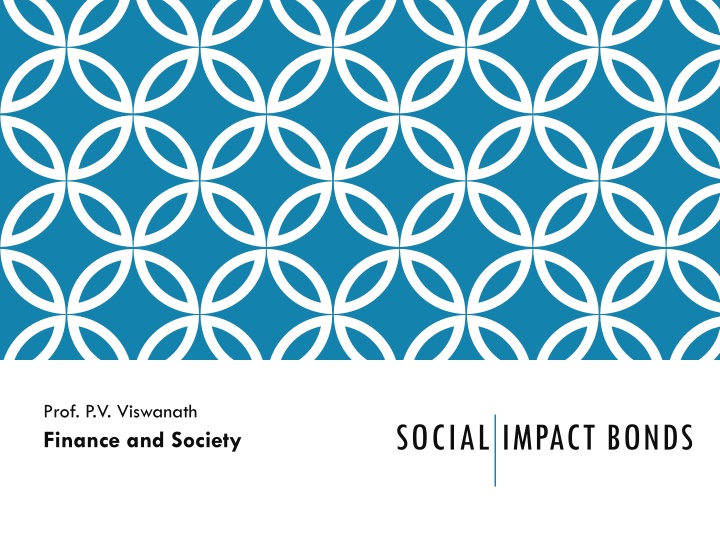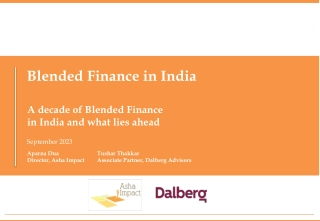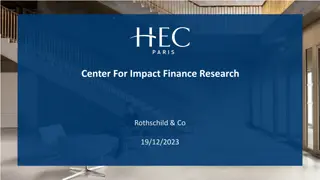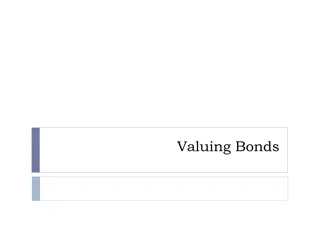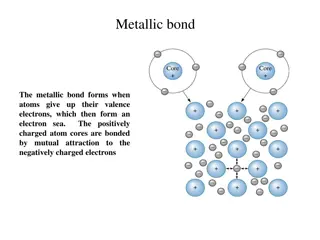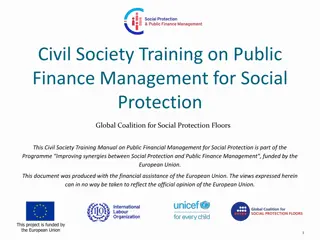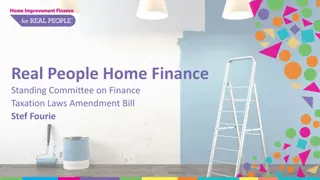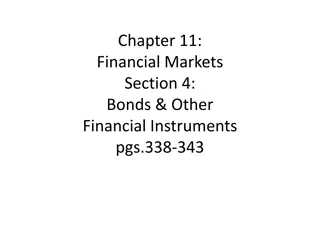Social Impact Bonds in Finance and Society
Social Impact Bonds (SIBs) are innovative financing mechanisms that involve partnerships between governments, social service providers, and investors to achieve predefined social outcomes. SIBs facilitate funding for programs with measurable impacts, with payments being made based on the achievement of agreed-upon goals. These bonds can support various initiatives, ranging from near-term cost savings projects to long-term societal benefits, and involve the collaboration of diverse intermediaries with expertise in finance, government, and social sectors.
Download Presentation

Please find below an Image/Link to download the presentation.
The content on the website is provided AS IS for your information and personal use only. It may not be sold, licensed, or shared on other websites without obtaining consent from the author.If you encounter any issues during the download, it is possible that the publisher has removed the file from their server.
You are allowed to download the files provided on this website for personal or commercial use, subject to the condition that they are used lawfully. All files are the property of their respective owners.
The content on the website is provided AS IS for your information and personal use only. It may not be sold, licensed, or shared on other websites without obtaining consent from the author.
E N D
Presentation Transcript
Prof. P.V. Viswanath Finance and Society SOCIAL IMPACT BONDS
WHAT ARE SOCIAL IMPACT BONDS? A SIB is an innovative financing mechanism in which governments or commissioners enter into agreements with social service providers, such as social enterprises or non-profit organizations, and investors to pay for the delivery of pre- defined social outcomes. More typically, an intermediary issues the bond to raise funds from private-sector investors, charities or foundations. It also coordinates with service providers to whom these funds are provided to help them cover their operating costs. If the measurable outcomes agreed upfront are achieved, the government or the commissioner proceeds with payments to the bond-issuing intermediary organization or the investors.
SIB OUTCOMES: CASHFLOWS? Many SIBS focus on programs with near-term cost savings as is the case with the Junior Code Academy SIB described later. However, it is possible that SIBs could finance programs that do not necessarily lead to savings or that offer longer-term or more diffuse savings. For instance, preschool programs for low-income children have been shown to be very effective, but their outcomes are manifest years later in the form of better high school graduation rates, improved health outcomes as adults, and lower crime rates. Government could agree to participate in SIBs for such public-sector priorities, despite a lack of sufficient levels of immediate savings to cover program costs. Alternatively, in lieu of government, corporations and foundations could participate as payors. Where corporations (such as health insurers) benefit from SIB programs, they may see an incentive to agree to pay investors if outcomes (such as smoking cessation) are achieved.
IDENTITY OF INTERMEDIARIES Intermediaries should have multi-disciplinary knowledge across the financial, governmental, and social sectors, and strong working relationships with evaluation firms and subject-matter experts. They aggregate and match finance, skills, physical collaboration space, evidence, technologies and networks. Some intermediaries have backgrounds in investment, some in design, some in the voluntary sector, and some in public services. They can come from one of many categories: Social venture funds; incubators; providers of technical assistance; service designers; impact monitoring agencies; specialist recruitment consultancies; skills and training organizations and providers of networks. In general, they form an infrastructure that serves organizations with a social, rather than purely profitable, focus.
THE NEED FOR SIBS Traditionally, nonprofit programs and social services have been supported by government and philanthropy. Limited funds are spread thinly across a fragmented nonprofit landscape. Commitments tend to be of limited duration and too small to achieve scale. Targeting funding to the most effective programs has proved challenging, as the social sector lacks sufficient measurement of participants outcomes. Nonprofits spend significant amounts of time raising short-term money and are constrained in their ability to develop longer- term strategies. The lack of long-term funding constrains nonprofits growth and contributes to a high degree of fragmentation within the social sector. The short-term imperatives of the election cycle leads government agencies to shy away from potentially risky, longer- term preventative investments.
BENEFITS OF SIBS Aligning the interests of nonprofit service providers, private investors, and governments, SIBs raise private investment capital to fund prevention and early intervention programs that reduce the need for expensive crisis responses and safety-net services. The government repays investors only if the interventions improve social outcomes, such as reducing homelessness or the number of repeat offenders in the criminal justice system. If improved outcomes are not achieved, the government is not required to repay the investors, thereby transferring the risk of funding prevention services to the private sector and ensuring accountability for taxpayer money. The long-term orientation allows a focus on funding for upstream prevention or early intervention programs that reduce the need for subsequent and more costly remediation.
POTENTIAL AREAS FOR SIBS Education Initiatives in this area could include, but are not limited to: reducing dropout rates; reducing truancy rates; and increasing graduation rates in community colleges; At-Risk Youth Initiatives in this area could include, but are not limited to: reducing recidivism rates for youth who are part of the juvenile justice system, diversion programs aimed at keeping at-risk youth out of the juvenile justice system, and increase rates of foster care youth achieving permanent placement; Adult Corrections Initiatives in this area could include, but are not limited to: reducing recidivism rates for adults who are part of the correctional system and diversion programs aimed at keeping at-risk individuals out of the correctional system; Public Health Initiatives in this area could include, but are not limited to: improving birth outcomes for at-risk women and reducing asthma related emergency room visits;
POTENTIAL AREAS FOR SIBS Behavior Health Initiatives in this area could include, but are not limited to: reducing recidivism rates in state mental health hospitals, reducing emergency room/inpatient care visits, and diversion programs aimed at keeping persons with behavioral health issues out of the correctional system; Supportive Housing Initiatives in this area could include, but are not limited to: moving persons with disabilities and/or mental illness from institutions into community settings and housing programs that are aimed at reducing recidivism into the correctional system; Veterans Initiatives in this area could include, but are not limited to: improving mental health treatment, reducing homelessness, and job training; Workforce Development Initiatives in this area could include, but are not limited to: workforce training programs for displaced workers, at-risk youth, public assistance recipients, individuals leaving the correctional system, or long term unemployed;
EARLY EXAMPLES OF SIBS In September 2010, Social Finance, Ltd., launched the world s first Social Impact Bond in the United Kingdom, which was targeted at reducing prison recidivism. The Ministry of Justice signed an agreement with Social Finance Ltd. to raise 5 million to fund services to 3,000 male, short-sentenced offenders at Peterborough Prison. Social sector organizations provided intensive support to prisoners and their families. If the recidivism (re-offending) rate were reduced by 7.5% or more, investors would received cash payments, which worked out to an ROI of between 2.5% - 13.3% p.a. over eight years.
SIBS IN THE US In January 2012, the Commonwealth of Massachusetts launched procurements to obtain intermediaries and providers for two social impact bond projects, and announced the selection of those partners in August 2012. The first project aimed to serve 900 youth over three years who were aging out of the juvenile justice system and expected to produce budget savings from reduced incarceration costs. The second project planned to house 400 chronically homeless individuals over a three-year period and expects to produce budget savings from reduced Medicaid spending. The objective was to improve social outcomes at reduced taxpayer expense, transfer performance risk from government to investors who might be more able to price and bear it, and reward high-performing nonprofits with long-term growth capital to scale proven innovations.
EXAMPLE: RECIDIVISM SOCIAL IMPACT BOND Goldman Sachs s Urban Investment Group launched the first social- impact bond in the United States in 2012 a $9.6 million loan for therapy services for juveniles incarcerated at Rikers Island. The transaction was structured as follows: Goldman made funds available to the nonprofit MRDC, and the nonprofit used the funds to hire the Osborne Association, which provides therapy services to incarcerated youth. MRDC was charged with overseeing the day-to-day implementation of the project. In addition, the Vera Institute of Justice, another nonprofit, was tasked with evaluating whether the program reduced recidivism among those at Rikers. The City of New York agreed to provide success payments to MDRC based on the projected savings from the reduced recidivism rate after five years, informed by the Vera Institute s evaluation.
SIB FUNDS There are two models through which governments and others have sought to provide funding; the SIBs funds and the individual SIBs. The main difference between them is that SIBs funds have the capacity to issue multiple contracts dealing with the same or similar social issues, whereas individual SIBs proceed to one payment contract at a time and they select among the structures presented below. In the cases of SIBs funds, the commissioning government establishes a rate card for payments per outcome. The prices indicated in the rate card are based on thorough research that examines the cost savings or reduced remedial assistance, which each outcome can yield. In this model, partnerships are often established between services providers, investors and intermediaries. These partnerships bid for contracts, which the SIBs funds provide, at a discount to the rate indicated in the rate card. Contracts are awarded to the selected bidders considering multiple factors among which is the discount indicated to their bid.
DIRECT SIBS In a direct SIB, a delivery contract is signed between the outcomes- payer and service provider or a services provider-controlled special purpose vehicle. In this case, the service provider is responsible for the implementation of the deal and the performance management. An intermediated SIB foresees that the delivery contract is signed between the outcomes payer and the investor, or an investor- controlled special purpose vehicle (SPV) or an intermediary, which identifies and contracts the service provider, supports the performance management process and refines the financial model. A managed SIB is signed between the outcomes- payer and the prime contractor (usually an intermediary) or an intermediary- controlled special purpose vehicle, who usually manages the entire process. The process is similar to the intermediated SIB, in terms of the activities of the intermediary. The main difference with the intermediated structure seems to be that the intermediaries have not invested in SIBs directly yet.
INTERMEDIATED STRUCTURE SIB EXAMPLE The following example illustrates the intermediated structure and is an individual model (as opposed to a fund). The Municipality of Lisbon, which is responsible for managing the primary education system, is the outcomes funder and the Junior Code Academy SIB, Portugal, assumes the role of service provider. The Calouste Gulbenkian Foundation invested 120 000 EUR in January 2015 and the Social Investment Lab is the intermediary. The Social Investment Lab is responsible for analyzing the social challenge, assisting in identifying outcomes metrics and evaluation methods, structuring the SIB and developing the financial model, raising capital, and assisting Code Academy in performance management and operations. The target group involves 65 students in 3 schools in Lisbon and ran for an initial period of 20 months. The students were given five semesters of computer programming classes delivered by the Code Academy.
INTERMEDIATED STRUCTURE SIB EXAMPLE The aim of the Junior Code Academy SIB it to tackle primary school grade repetition and drop-out and to generate evidence about the impact of computer programming in cognitive skills, including school performance and problem solving ability, in order to inform public policy. There were two outcomes sought from the SIB: To generate savings for the Central Government, which is responsible for high school education due to fewer students repeating grades. To improve the reasoning ability of the students who participated in the program. Students who participated in the project showed superior performance in mathematics and an improvement in their logical reasoning ability. Based on this, the Municipality of Lisbon partly reimbursed the Calouste Gulbenkian Foundation; however, the Foundation has only received 25% of the initial upfront investment. One problem here is that the Lisbon municipality makes the payments, whereas the central government gets part of the savings.
SIBS AND MUNICIPAL BONDS Social Impact Bonds differ from municipal bonds and other fixed-income instruments that are often used for infrastructure or other capital projects. SIBs share features of both debt and equity. The instrument has a fixed term of between five and ten years, and the upside is capped, but, like equity, returns vary based on performance. Compared to a typical debt instrument, investors bear a higher risk of losing all of their principal. These investments are not backed by hard assets or cash flows, as municipal funds usually are. To manage the associated risks, an intermediary will engage in project management over the life of the instrument, much like an active asset manager, to ensure that long-term outcomes and the collective objectives of all the parties are achieved.
PAYMENT-BY-RESULTS CONTRACTS AND SIBS SIBs are a subset of payments-by-results, pay-for-performance or results-based financing mechanisms, which link funding to results, while providing supporting process innovation in the public sector and, finally, better performance from services providers. Here are some differences: SIBs involve private sector investors establishing a wider stakeholder platform and focusing on their effective cooperation and coordination. They focus on outcomes rather than outputs. For example, outputs-based rewards focus on the number of people who have completed a substance- abuse recovery program. Outcomes-based rewards would focus on the number who remain sober for an extended period of time or reductions in drug-related crime. They allow for up-front funding for the interventions, which enables service providers to focus their efforts on the service delivery rather than on fundraising. SIBs transfer the implementation risk from the public sector or the service providers, which they would have been otherwise unable to bear, to the private sector.
PAYMENT-BY-RESULTS CONTRACTS & SIBS SIBs could be thought of as extending the basic concept under payment-by-results contracts. Start out with a government agency using in-house employees to accomplish a certain task, e.g. to manage a half-way house for former prisoners. The next step would be that the agency might outsource this to a Social Service provider (SSP) and pays the costs or according to some formula where the SSP would be provided a certain amount for each prisoner that it manages. A third level would be where the agency outsources the work to the SSP, but the payment would be not for output but for outcomes. Since the purpose of the half-way house is to ease prisoners into the outside world and reduce recidivism, payment could be related to the number of prisoners still outside jail after a certain period of time. This would, however, still leave the SSP required to come up with its own financing to obtain the up-front capital. Especially if the SSP is a non-profit, which may be desirable in terms of outcomes, this may be difficult. Many non-profits send a lot of time and energy in raising funds for their work.
PAYMENT-BY-RESULTS CONTRACTS & SIBS Finally, in an SIB, up-front funding is raised by an intermediary, which would then contract with the government agency and also hire the SSP to do the work. These investors may also be better able to bear the risk of delayed payments or lower payments or no payments at all, compared to a non-profit organization. Even if the SSP does a good job ex-ante, ex post outcomes cannot be guaranteed and issuing bonds would be a good way to lay off this risk on investors who can bear it better. The SIB, thus, has several advantages: It provides up-front capital, which might be easier to do in the private sector than by a government agency, which has to deal with political issues. The intermediary will be better situated to provide monitoring of the SSP to ensure that it does a good job. The SSP is relieved of the burden of bearing the risk of outcomes not being satisfactory. The agency need only pay for satisfactory outcomes rather than simply output. The SIB process could release cost savings for the agency.
GREEN BONDS Green bonds earmark funds for corporate projects that benefit the environment. These bonds were invented by the World Bank in 2007; investment in green bonds has escalated since then, breaking a record with $107 billion issued in the first half of 2019. In the case of a green bond, an issuer solicits funds for a green project, defined as a project with a positive environmental benefit. Importantly, the bond price is generally the same as an ordinary bond from that issuer, and recourse is also the same. The main difference is that the funds are earmarked for qualifying green projects. There is evidence that green bonds have the same yield as brown bonds! K. Thomas Liaw, Survey of Green Bond Pricing and Investment Performance, 13 J. Risk & Fin. Mgmt. 193, 203 (2020)
SUSTAINABILITY BONDS Sustainability bonds are similar to green bonds, but address both social and environmental issues. The U.S. pharmaceutical firm Pfizer in late March 2021 issued its first sustainability bond, a 10-year US$1.25 billion issuance. The security pays a yield of 2.63%, slightly higher than other new issuances, according to Morgan Stanley research. Capital is earmarked for various purposes, including minimizing the firm s environmental impact and addressing the global Covid-19 crisis through different channels, including supporting access to medicines and vaccines by populations in need. Two other recent issues were by the International Finance Corporation (IFC), a private investment development organization based in Washington, D.C. The group sold one bond to support emerging-market companies that manufacture or distribute medical equipment and pharmaceuticals, and another to help private businesses and employees impacted by the global economic slowdown
LIMITS OF SUSTAINABILITY AND GREEN BONDS These are bonds that are profitable for companies; which is why they issue it. However, since they contribute to ESG goals, they are also attractive to investors beyond ordinary corporate bonds. The cost of such debt capital may be somewhat lower depending on how many investors there are out there that are willing to take a lower rate of return as quid pro quo for being able to invest in green projects. This allows corporations to invest in socially desirable projects, as long as the IRR for a such projects is greater than the yield on these green bonds. However, what if there are social desirable projects with externalities, positive and negative, such that firms would not willingly invest in them at such yields? CSR bonds are intended to address such cases.
CSR BONDS A CSR bond is similar to a green bond, except that the investor would eschew any financial gain even if the project is successful; the expected return is the social benefit. The issuer (likely a third-party nonprofit) would first identify a corporate action that is not wealth maximizing but that would have a large positive impact on stakeholders or the broader community. The issuer would then raise money to entice the company to make the decision. It would do this by issuing a bond, describing in a detailed offering document how the company could use the proceeds and certifying that the company would not make the decision without the investment. If the company agreed to participate, the non-profit would loan the money to the company using a promissory note. If the project was implemented according to the offering document, the loan would be forgiven. If not, investors would get their money back plus penalty interest paid by the company.
CSR BONDS: THIRD PARTY ISSUER The reason that the issuer is a third party and not the company itself is that the promissory note is a private transaction and monitoring and certification of company actions would be easier. Using a third-party issuer also reduces coordination costs and removes the onus from the company and instead puts it on NPOs that, presumably, are already interested in such outcomes and are set up to promote such actions. If the company itself issues the bonds, there is the problem of moral hazard. The company could lay out a straw man alternative with respect to which, the proposed investment reduces GHG emissions, e.g. This makes it desirable for the issuer to be a third party. An issuer might refuse to work with a company that seeks out a bond. Or, an issuer could adopt a policy of only working with companies that have made genuine efforts at improving their ESG activities over time. Both strategies should reduce the risk of moral hazard whenever CSR bonds are used.
BENEFITS OF CSR BONDS CSR bonds could not just alter practices at the targeted company, but also transform entire industries. For example, McDonald s buys 3.4 billion pounds of potatoes approximately 7% of U.S. production. Therefore, the company has the ability to alter supply chain dynamics as a buyer. If a CSR bond was used to push McDonald s to buy organic potatoes, the developing norm could encourage other companies to follow suit. CSR bonds could also be used to overcome coordination costs for prosocial individuals. For example, Walmart is one of the biggest sellers of guns in the world. If a nonprofit promised Walmart funds if it stopped selling guns, the possibility of changing Walmart s practices might overcome coordination costs of dispersed individuals who value a prosocial corporate decision. Finally, corporate philanthropy is likely to provide a higher marginal return than individual philanthropy aimed at accomplishing the same result. For example, a CSR bond aimed at keeping Harley-Davidson operating in the US and maintaining jobs in the US would require less money for the same buck because of the intermediary s bargaining power.
GREEN/SUSTAINABILITY BONDS VS CSR BONDS The main difference between a green bond and a CSR bond is that the latter are designed to push companies to make profit-sacrificing projects. By contrast, a green bond simply allows companies to secure funding for profit-maximizing green projects projects that would be worth the cost of the debt. Any individual who values the decision more than its cost could contribute to a CSR bond. To provide an incentive to depart from wealth maximization, the individuals would stipulate that their contribution would be forgiven if the decision was implemented, therefore allowing the company to undertake projects that are socially optimal, but not optimal in a narrow corporate cashflow sense, at market rates. If the company fails to act, however, the investor would get their money back plus penalty interest, which serves as a commitment mechanism for the issuer. The advantage of this is that the investor gets a way to not only take a lower yield in return for socially desirable outcomes, but actually to take a negative return. The penalty in case the firm should not follow through also provides a further incentive. In order to ensure that the promised action gets undertaken, bondholders could secure information rights or the right to monitor operations until the scrubbers are installed. This would make it different from a standard bond that has a specific use specified in the bond indenture.
SOURCES Understanding Social Impact Bonds, OECD Working Paper, 2016. https://www.oecd.org/cfe/leed/UnderstandingSIBsLux- WorkingPaper.pdf Dorothy S. Lund, Corporate Finance for Social Good, Columbia Law Review, June 2021, Vol. 121, No. 5, pp. 1617- 1658 Cynthia Shanmugalingam, Jack Graham, Simon Tucker and Geoff Mulgan Growing Social Ventures, NESTA Policy Paper. https://youngfoundation.org/wp- content/uploads/2012/10/Growing-Social-Ventures-2011.pdf Social Finance Inc. Report: Social Impact Bonds: An Overview. Hajer, Jesse and John Loxley. 2021. Social Service, Private Gain, Toronto: University of Toronto Press.
